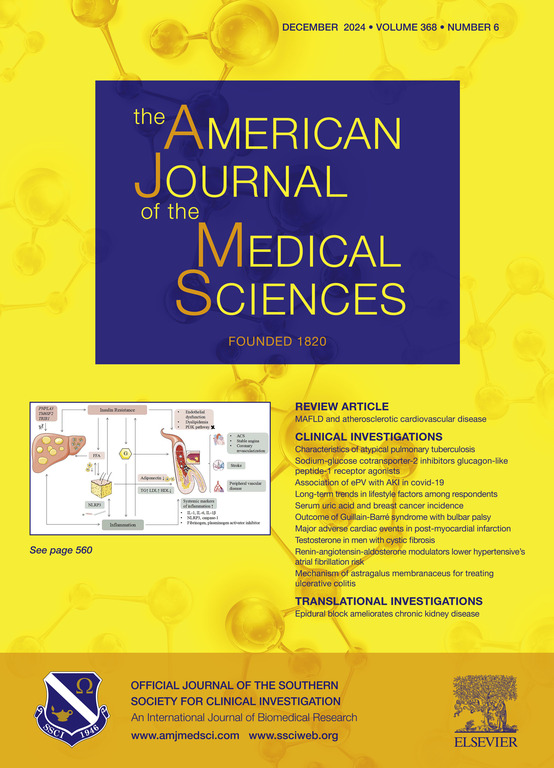Comparison of 24 vs 72-hr octreotide infusion in acute esophageal variceal hemorrhage - A multi-center, randomized clinical trial
IF 2.3
4区 医学
Q2 MEDICINE, GENERAL & INTERNAL
引用次数: 0
Abstract
Background
Current guidelines lack clarity about the optimal duration of octreotide therapy for patients with esophageal variceal hemorrhage (EVH). To address this lack of evidence, we conducted a randomized clinical trial (RCT) of 24-hr versus 72-hr continuous infusion of octreotide for patients with EVH.
Methods
This multi-center, prospective RCT (NCT03624517), randomized patients with EVH to 24-hr versus 72-hr infusion of octreotide. Patients were required to undergo esophageal variceal band ligation prior to enrollment. The primary endpoint was rebleeding rate at 72 hr. The study was terminated early due to an inability to recruit during and after the COVID-19 epidemic.
Results
For patients randomized to 72-hr (n = 19) of octreotide vs 24-hr (n = 15), there were no differences in the need for transfusion, average pRBC units transfused per patient (3 units vs 2 units), infection (5% vs 0%), mechanical ventilation (11% vs 7%), or the need for vasopressors (5% vs 3%), respectively (none of these differences were statistically significantly different). There were 2 re-bleeding events in the 72-hr group (11%), and no re-bleeding events in the 24-hr group (p = 0.49). 8/15 of patients receiving 24 hr of octreotide were discharged at or before hospital day 3 while none in the 72-hr group was discharged before day 3 (p < 0.001). There was one death (in the 72-hr group) within 30 days.
Conclusions
A 24-hr infusion is non-inferior to a 72-hr infusion of octreotide for prevention of re-bleeding in patients with EVH. We propose that shortened octreotide duration may help reduce hospital stay and related costs in these patients.
在急性食管静脉曲张出血中输注 24 小时与 72 小时奥曲肽的比较--一项多中心随机临床试验。
背景:目前的指南没有明确食管静脉曲张出血(EVH)患者接受奥曲肽治疗的最佳时间。为了解决证据不足的问题,我们开展了一项随机临床试验(RCT),对食管静脉曲张出血患者连续输注奥曲肽 24 小时与 72 小时进行对比:这项多中心前瞻性 RCT(NCT03624517)将 EVH 患者随机分为 24 小时输注奥曲肽和 72 小时输注奥曲肽两种。患者必须在入组前接受食管静脉曲张带结扎手术。主要终点是72小时后的再出血率。由于在 COVID-19 流行期间和之后无法招募到患者,研究提前终止:随机接受 72 小时奥曲肽治疗(19 人)与 24 小时奥曲肽治疗(15 人)的患者在输血需求、每位患者平均输注 pRBC 单位(3 单位 vs 2 单位)、感染(5% vs 0%)、机械通气(11% vs 7%)或血管加压药需求(5% vs 3%)方面分别没有差异(这些差异在统计学上都没有显著性差异)。72 小时组有 2 例再出血事件(11%),24 小时组无再出血事件(P = 0.49)。在接受 24 小时奥曲肽治疗的患者中,8/15 的患者在住院第 3 天或之前出院,而在 72 小时组中,没有患者在住院第 3 天之前出院(p < 0.001)。有一名患者(72小时组)在30天内死亡:结论:在预防EVH患者再出血方面,24小时输注奥曲肽并不比72小时输注奥曲肽效果差。我们认为缩短奥曲肽的输注时间有助于减少这些患者的住院时间和相关费用。
本文章由计算机程序翻译,如有差异,请以英文原文为准。
求助全文
约1分钟内获得全文
求助全文
来源期刊
CiteScore
4.40
自引率
0.00%
发文量
303
审稿时长
1.5 months
期刊介绍:
The American Journal of The Medical Sciences (AJMS), founded in 1820, is the 2nd oldest medical journal in the United States. The AJMS is the official journal of the Southern Society for Clinical Investigation (SSCI). The SSCI is dedicated to the advancement of medical research and the exchange of knowledge, information and ideas. Its members are committed to mentoring future generations of medical investigators and promoting careers in academic medicine. The AJMS publishes, on a monthly basis, peer-reviewed articles in the field of internal medicine and its subspecialties, which include:
Original clinical and basic science investigations
Review articles
Online Images in the Medical Sciences
Special Features Include:
Patient-Centered Focused Reviews
History of Medicine
The Science of Medical Education.

 求助内容:
求助内容: 应助结果提醒方式:
应助结果提醒方式:


